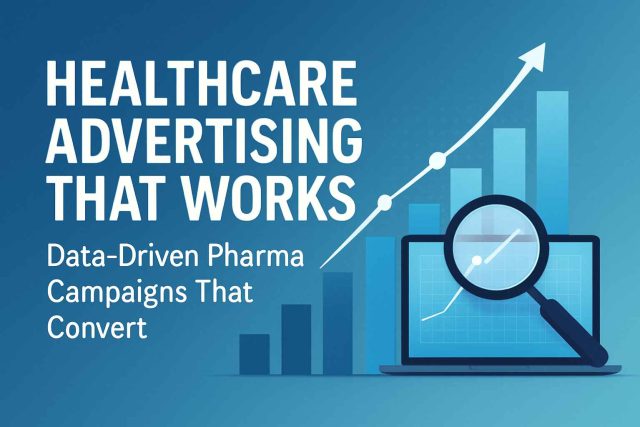
Is your healthcare advertising generating the conversions your pharma brand needs? In today’s competitive, digitally saturated market, traditional messaging no longer cuts it. Precision targeting, performance insights, and adaptive content are essential to reach both healthcare professionals (HCPs) and patients effectively. Fortunately, the rise of data-driven strategies is helping marketers build more intelligent campaigns that truly convert.
This article explores how pharma brands can optimize healthcare advertising using data science, automation, and omnichannel engagement—without violating privacy laws or patient trust.
Table of Contents
- The New Rules of Healthcare Advertising
- Using Data to Drive Smarter Pharma Campaigns
- What Makes a Campaign Convert?
- Future Trends and Takeaways
The New Rules of Healthcare Advertising
Gone are the days of one-size-fits-all direct-to-consumer (DTC) messaging. Pharma marketers must now navigate a complex ecosystem of regulations, fragmented digital touchpoints, and discerning audiences. Healthcare advertising in 2025 must be:
- Contextual: Ads should meet the user at the right moment with the right message.
- Compliant: Campaigns must align with HIPAA, GDPR, and FDA guidelines.
- Insight-Driven: Data is more than targeting—it’s about crafting emotionally resonant messages.
Platforms like eHealthcare Solutions and programmatic ad tools give brands the power to reach HCPs and patients where they’re actively seeking information—on niche medical sites, forums, and journal apps.
For pharma marketers, this means leveraging AI, behavioral analytics, and predictive modeling to boost ad performance without wasting budget.
Using Data to Drive Smarter Pharma Campaigns
So how does data transform healthcare advertising from generic to high-performing?
1. Audience Segmentation and Personalization
Data enables marketers to break large audiences into highly defined segments based on disease type, content behavior, search history, and prescription activity. With that granularity, you can deliver personalized messages that meet people where they are in their treatment journey.
2. Omnichannel Engagement
Effective campaigns deliver consistent messaging across multiple channels: programmatic display, email, native ads, social media, search engines, and even HCP portals. Integrating these touchpoints ensures brand consistency and higher recall.
3. Real-Time Optimization
Data lets you iterate mid-campaign. Marketers can quickly assess which creatives, CTAs, and platforms drive the best outcomes—and reallocate budget accordingly. This agility is key for time-sensitive treatments or seasonal conditions.
4. Predictive Targeting
With machine learning, brands can anticipate behavior based on previous engagement, search queries, or claims data. This not only improves ROI but helps patients find treatments before symptoms worsen.
Learn more about how advanced targeting is evolving in the pharma space at Pharma Marketing Network.
What Makes a Campaign Convert?
While data fuels targeting, conversion depends on creative execution. Healthcare advertising must balance clarity, empathy, and actionability. Below are the elements that consistently produce high-converting pharma campaigns:
Clear Value Proposition: Whether it’s symptom relief, patient assistance, or improved adherence, the ad must instantly communicate its core benefit.
Emotionally Intelligent Messaging: Storytelling still matters. Patient-centric language, testimonials, or empathetic imagery help brands forge deeper connections.
Frictionless Landing Pages: Your ad worked—now what? Optimize landing pages for mobile, reduce load time, and eliminate unnecessary steps to form fills or HCP finder tools.
Trust Signals: Include third-party logos, medical references, or FDA-clearance language where permitted. Transparency fosters conversions.
Retargeting with Purpose: Follow users across the web with fresh variations of messaging. But be sensitive to patient privacy and preference controls.
A well-executed healthcare advertising campaign not only delivers conversions but also improves awareness, retention, and patient outcomes.
Future Trends and Takeaways
Healthcare advertising is evolving fast. To stay ahead, pharma marketers should keep an eye on these trends:
- Voice and Visual Search: Patients increasingly use voice-enabled search and image recognition. Ads need to adapt for these formats.
- AI Copywriting and Creative Testing: Tools that generate and test dozens of ad variations will enhance campaign performance at scale.
- Outcome-Based Metrics: Impressions are not enough. Success metrics will include engagement quality, patient education levels, and script fulfillment.
- Privacy-First Targeting: Contextual advertising—based on content rather than cookies—will play a bigger role as third-party data becomes scarcer.
By leaning into innovation and leveraging platforms like eHealthcare Solutions and insights from Pharma Marketing Network, brands can future-proof their digital strategy and deliver meaningful impact.
FAQs
What makes healthcare advertising different from other industries?
It’s heavily regulated, audience-specific, and must be compliant with laws like HIPAA and FDA guidance.
How can pharma brands personalize ads without violating privacy?
Using anonymized or contextual data allows for targeted messaging without tracking identifiable information.
Do HCP-targeted campaigns differ from patient ads?
Yes, HCP ads focus on clinical efficacy, MOA, and peer-reviewed data. Patient ads are more emotional and outcome-focused.
Can AI improve campaign conversions?
Absolutely. AI can analyze patterns, predict engagement, and test multiple ad creatives for better results.
Where can I learn more about successful pharma marketing strategies?
Explore expert resources and case studies at Pharma Marketing Network.
Disclaimer:
This content is not medical advice. For any health issues, always consult a healthcare professional. In an emergency, call 911 or your local emergency services.